Beauty of birds in the South Central Highlands
Under the impact of people and creatures in the South Central Highlands region is decreasing, the image of precious birds gradually disappears.

Nectariniidae (Nectariniidae). The food of most molasses is nectar, some species feed on insects when feeding young birds. Vietnam has captured samples of bile-sucking birds in Di Linh, Tay Ninh, Bien Hoa and Phu Quoc.

Close up of the big Moroccan bird. There are 84 species in the world, of which Vietnam has 10 species of Barren birds. Their characteristics are very large in mines and heads, the largest species has an average weight of about 210g, about 33cm long. They live in the natural environment of forests, eating insects and fruits. Figs are their favorite food. Moroccan is thought to be an important agent in spreading seeds in tropical forests.

Dicrurus leucophaeus baker (Dicrurus leucophaeus baker). In Vietnam, gray paddies nest in mountainous areas of the northern provinces, but the number is not much, they migrate to the south in the winter.
Gray greyhounds feature: gray ash gray back with green steel, the abdomen of ash gray is slightly lighter, with very faint steel light, gray wings and tail with purple and green light, obscured parts of pale black wing feathers .

Langbiang Mavis (Crocias langbianis) - one of Vietnam's endemic species. Ho mi Langbiang is also known as Mi Mountain Ba is a rare species of the passerine, the Babbler. This bird can only be found at altitudes above 1,500m.

Blue Bird (Chloropseidae). They are one of three endemic families of Indomalaya ecoregions. These birds are shaped like crests (Pycnonotidae), living in forests. Although this group tends to be grayish brown, they are heterosexual, with males having green and yellow fur.
Green birds often eat fruits, honey and sometimes eat bugs. They have sharp blades, suitable for eating honey. They lay 2-3 eggs in the nest on the tree.

Black-spotted bird (Hypsipetes leucocephalus Gmelin). In Vietnam, in winter, this subspecies occurs in mountainous areas from the northern border to Hai Van and Lam Dong passes (Bidoup Nui Ba).
Adult males have a characteristic head, neck and upper chest. The rest of the coat is black or light, sometimes with brown streaks. Under the tail sometimes there is a white border. The female has a male-like plumage but the belly is usually dark gray. The coat of this subspecies has many changes, it is possible to encounter individuals whose heads are much less hairy.

Big Bird (Green-billed Malkoha). This is a bird with dorsal hair that is dark gray, slightly greenish, the wing feathers and tail feathers are slightly darker but the green light is more, the tail feathers are white, the hair on the chin, throat and chest fringes out; Gray chest and abdomen. In Vietnam, this species is found in the South Central and Southern part. They often live in the forest edges of wooded areas.

Red-headed Cuckoo (Megalaima asiatica). In Vietnam, this species is found in most areas, heavily wooded places and not more than 800m high.

Pink throat. On the picture is the male. The drum has the characteristic: The top of the hexagonal steel head has yellow light; eyes, cheeks, ears, sides and neck, upper back, secondary wing feathers and black velvet wing feathers; lower back, shoulders and wing feathers on the shoulders, hips and reddish-green tails.

Pink bird - Female. Females are characterized by a yellowish dorsal surface with hairs on the top of the head with dark streaks in the middle of the coat; black tail; brown wings slightly edged hung; The middle tail has a white border at the tip.
- The Central Highlands and the South appear rotten season
- The North continues to be cold, the Central and South Vietnam have heavy rain
- Scientists found 8 new orchids in the Central Highlands
- Central and Central Highlands worry that El Nino will appear
- Starting Robocon 2012 in the Central region - Central Highlands
- Cultural space of Cong Chieng Highlands
- Tropical depressions cause heavy rain in the Central and Central Highlands
- Poisonous picture of the elephant hunt in the Central Highlands 100 years ago
- Record flooding in Phu Quoc and Central Highlands due to the monsoon in Australia
- Vietnamese groundwater resources decline
- Successfully rearing red pheasant species in the Central Highlands
- Birds also know beauty
 Animal 'suffering' after hibernation
Animal 'suffering' after hibernation Why do goats climb well?
Why do goats climb well? Scientists were surprised to see chimpanzees eating turtles
Scientists were surprised to see chimpanzees eating turtles Giant catfish died deadly due to drought in Thailand
Giant catfish died deadly due to drought in Thailand